Silver Anniversary Rose with a scattering of Confetti (Mix)
Confetti for this wedding related rose wasn’t a planned companion planting.
It was only in reviewing photos I realised this fun, accidental spin.
Virginian Stock ‘Confetti Mix’ seeds sown direct in border back on May 23rd.
Confetti mix was intended as summer filler in area of limited planting depth.
Traditional companion planting is much more practical. Growing French marigolds near tomatoes is the first planting that comes to my mind here. I have childhood memories of my Mum doing this (the strong smelling Marigolds were believed to be good at repelling greenfly and blackfly). Ha-ha… the Marigolds certainly repelled myself and my siblings from touching the growing fruits that’s for sure!
Companion planting is all about creating plant communities which have mutual benefits to each other. It can be an organic way to protect your crops from pests or it could help improve pollination of fruit and vegetable crops. Although there is limited scientific research surrounding companion gardening, many gardeners find it extremely beneficial to their plant’s performance. In this article we’ve put together the best known partnerships in flowers, herbs and vegetables to help you improve the health of your garden plants without needing to resort to pesticides.
Companion Planting Guide, Thompson & Morgan
Combining your plants in the right way can be good for their health and growth, as well as from an aesthetic point of view. This guide explains which species can work together and what the key benefits are.
Companion planting, Gardening guides, BBC
Planting combinations for pollinators can be seriously rewarding for the gardener too. This year our small front garden, main border above, has been an absolute joy to see grow and become a-buzz with bees, butterflies and other insects. This area was given a raised path edge earlier this year and has become everything I hoped it would be and more.
Last year’s plant residents enjoying this sunny spot (Buddleja ‘Buzz Ivory’, Drumstick Alliums, Sedum, Foxglove ‘Milk Chocolate’ & Acanthus) have been joined this year by new edging strips of Lavender & Thyme, a white Echinacea (Coneflower), Verbena bonariensis ‘Lollipop’ and Aubrietia cascading over the rocky wall edges.
August just had to bow out with a few more images to look back on. The next sunny evening we get, I’ll take a seat out here and sit with my cameras… that will be my reward for the hard work in removing a tired but well-loved, well-behaved bamboo that has given up a prime sunny space for plants to attract pollinators.
Lucky iPhone capture of small tortoiseshell butterfly 🙂
This post was published by Shirley for shirls gardenwatch in August 2015.
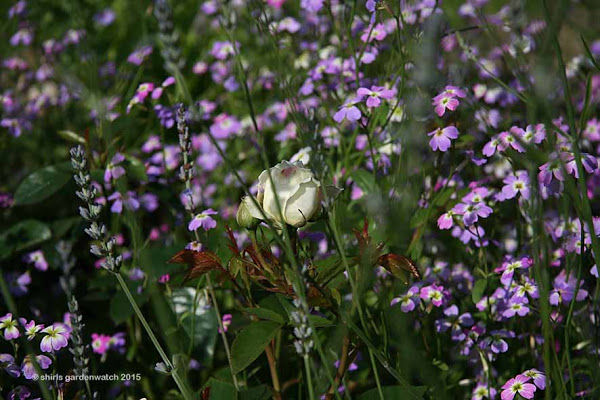
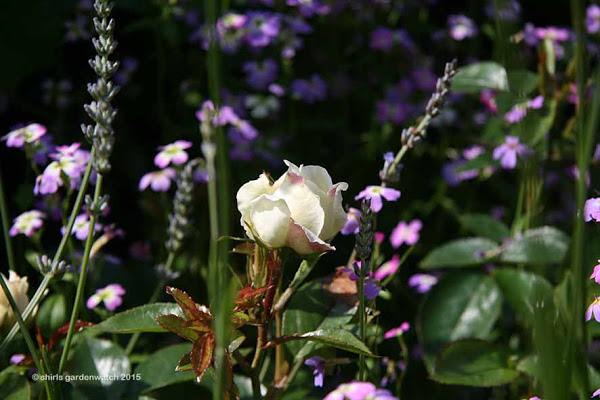
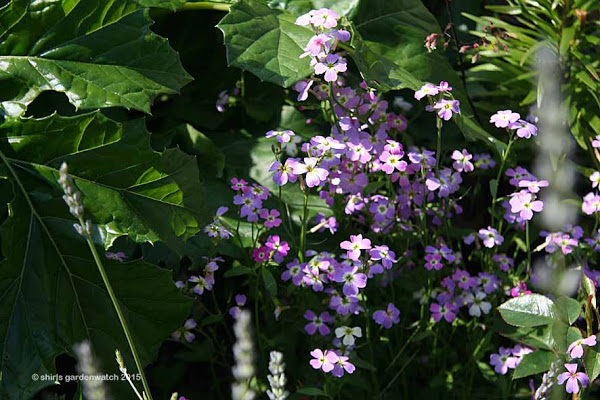
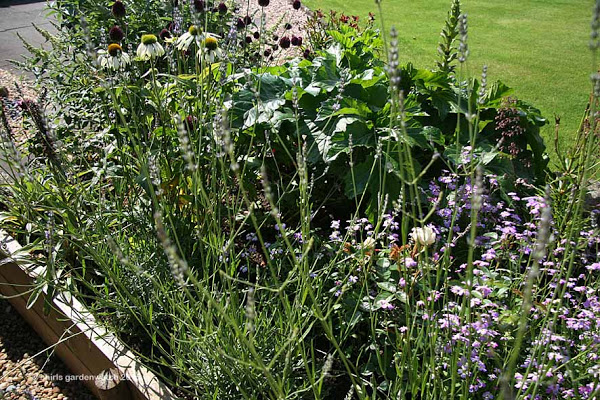
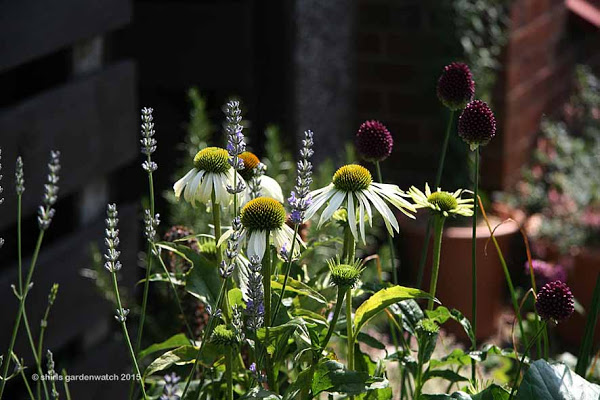
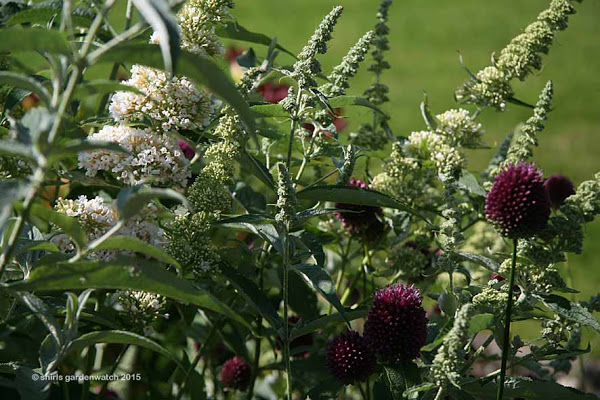
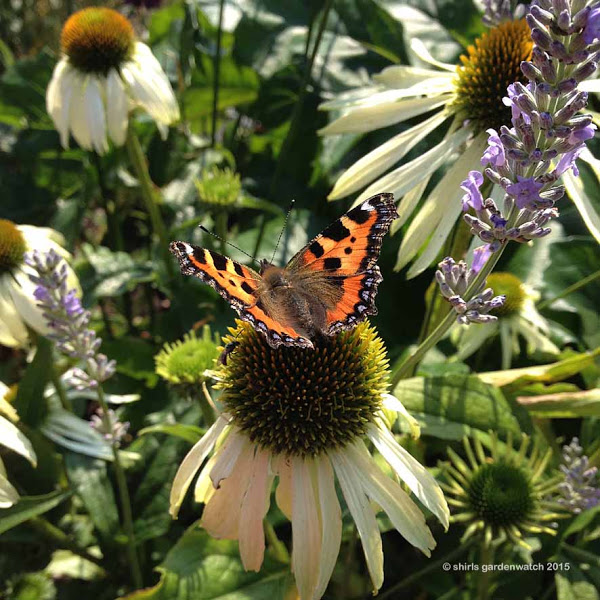
Your garden looks so good whether you meant to have such companion plants or not. My poor garden is about burned up. We have had two months of little to no rain. I have only seen silver spotted skippers in my garden lately. I guess that is good considering the circumstances.
Wonderful pictures of wonderful spots in your garden. This 'alternative companion planting'looks great!
Wish you lots of fun watching your garden.
Janneke
We were given a 'Silver Anniversary' rose on the aforesaid occasion Shirl but I've not taken to it at all and it' still in the pot it came in. The flowers look awful when it rains and I can't detect any scent 🙁 It does looks good in your garden though with the scattering of confetti. What a beautiful white echinacea!
Lovely combination, and a great play on their names. Your images whether of birds or flowers are always superb; sorry I don't always comment but it isn't possible if I read your posts on an IOS device, Google need to work something out for that, but I always enjoy your posts. Chrisitna
Virginia and night scented stock are plants from my childhood. I was always given a packet of each to soe each year.
All so lovely. Not so creative anymore…well at least not for the last 3 years. Happy your keeping garden blogging active.
I use companion planting a lot in the kitchen garden, but I've never managed to create a wedding themed combination. What beautiful photos!
Hello again to you all, thanks for popping by and leaving your comments. Sorry I’ve been slow to reply 🙂
Lisa, thank-you 🙂 The lovely green lawn is not mine btw, it is well maintained by my neighbour. He doesn’t have many plant borders and I don’t have a lawn out at the front so we’ve a bit of neighbourly companion planting here 😉 Lack of rain isn’t usually a problem here but I have remembered in the past you’ve had droughts in Indiana a few times over our blogging years. Wishing you more rain and butterfly sightings 😀
Janneke, thank-you! I’s so enjoying walking up this (front of fence) path with plants at a raised height. It’s a great private view form the path side and another quite different aspect for my neighbours. I’m really very pleased how this has turned out although the bred to be small buddleja ‘Buzz’ is getting a little big and is shadowing some plants (its position there will be under review next year)
Anna, white flowers can have a problem in rain can’t they? Thanks, not many flowers from this rose this year so confetti was the right height. Will need to see what replaces the confetti next year. I have loved that coneflower!
Christina, thank-you, I had a bit of fun with this. Thank-you for your very kind comment, I’m sorry you can have issues leaving them. I can get that myself at times and its disappointing if I’ve written a long one.
Sue, ah… childhood memories of plants are wonderful. Wild flowers on woodland walks would always be mine. I can’t remember being given a pkt of seeds. However I took over my parent’s rock gardens at age 10. My love of alpines and working with stone began then 🙂
Patsi, hello there! Nice to see you popping by again 🙂 It’s hard to be creative when things in life aren’t so easy. My blog has been lean on posts but I love to connect back with the same enthusiasm as I had back in the beginning 🙂
Sarah, Thank-you! My combination was a fluke of sorts but a fun one had I planned it or not. Kitchen gardens really do benefit from companion planting (so I have heard and read about many times). Thanks for stopping by 🙂